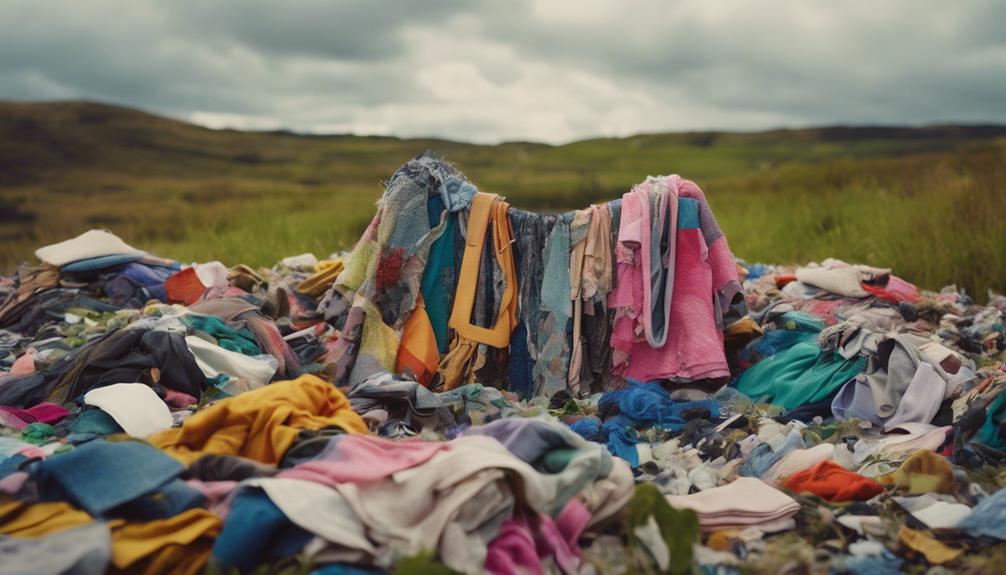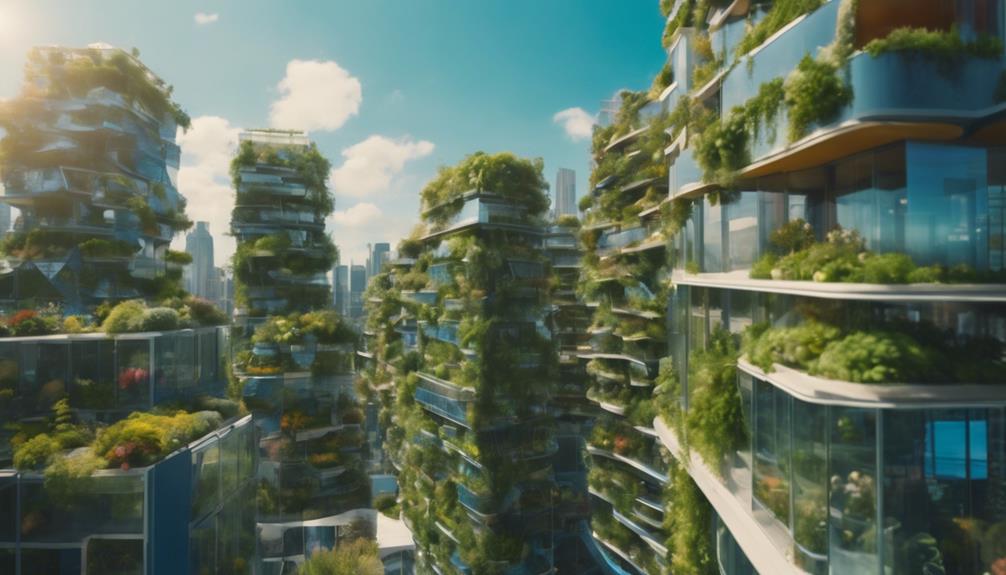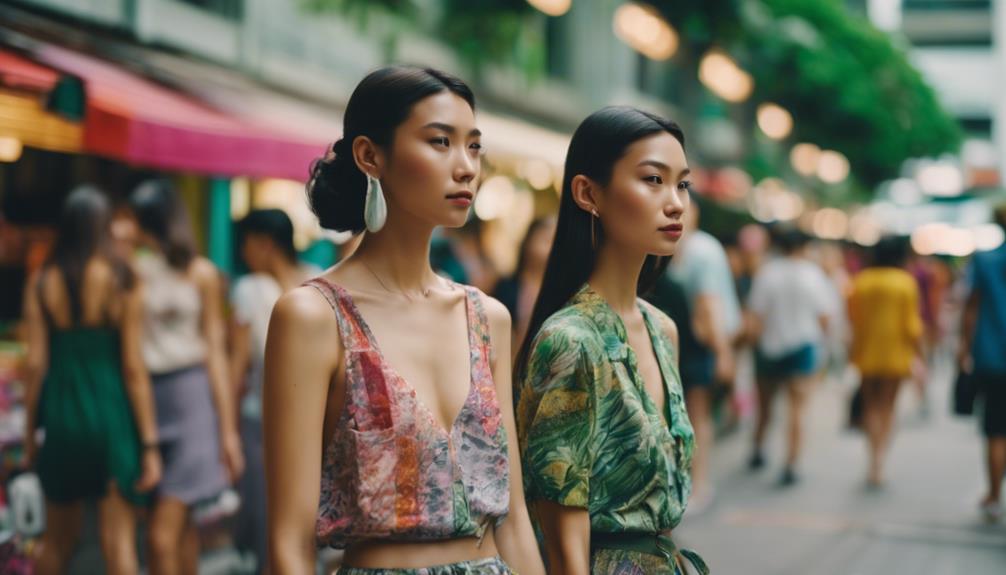You need to consider sustainable fashion because it is crucial for our planet and its people. Fast fashion is responsible for 10% of global carbon emissions and produces 92 million tons of textile waste annually. This pollution negatively impacts ecosystems and communities. Sustainable practices can help minimize this impact, as many consumers are willing to pay extra for eco-friendly options. Additionally, ethical fashion supports fair labor practices and safe working conditions for garment workers. By making informed decisions, you can help steer the industry towards a more sustainable future. Stay tuned to learn more about the significance of your choices!
Key Takeaways
- Fast fashion contributes to 10% of global carbon emissions, worsening climate change and environmental degradation.
- Approximately 92 million tons of textile waste are generated annually, with 60% discarded within a year.
- Sustainable fashion can significantly reduce water consumption, using 91% less water with organic cotton compared to conventional methods.
- Supporting ethical fashion promotes fair labor practices, ensuring workers receive fair wages and safe working conditions.
The Impact of Fast Fashion
Fast fashion's rapid production cycle is wreaking havoc on the environment, contributing to climate change and generating massive amounts of waste. You mightn't realize that the fashion industry is responsible for about 10% of global carbon emissions. This staggering statistic highlights fast fashion's significant environmental impact.
Each year, around 92 million tons of textile waste end up in landfills, with approximately 60% of clothing items discarded within just one year of purchase. Moreover, producing one kilogram of cotton consumes an astonishing 22,000 liters of water, showcasing the excessive water usage linked to fast fashion. The production processes often involve toxic chemicals and pesticides that pollute waterways and harm ecosystems, reflecting the hidden costs of cheap clothing.
As you consider your wardrobe choices, it's essential to understand that opting for sustainable fabrics can help mitigate these issues. By choosing materials that are produced responsibly, you can reduce the environmental impact of your clothing.
It's time to rethink your fashion habits and become more aware of the broader implications of fast fashion on our planet.
Benefits of Sustainable Practices

Embracing sustainable practices in fashion not only protects the environment but also creates a more ethical and resilient industry. By choosing sustainable fashion, you contribute to a notable reduction in the fashion industry's environmental impact, which currently accounts for about 10% of global carbon emissions.
For instance, using organic cotton helps decrease water consumption—did you know it takes up to 1,800 gallons to produce just one pair of jeans? When the industry prioritizes sustainable materials, like organic cotton and recycled fibers, it reduces reliance on virgin resources. Currently, only 3% of clothing production utilizes recycled materials, while a staggering 97% depends on new resources.
By adopting sustainable practices, we can also tackle the 92 million tons of textile waste generated annually, as these initiatives can notably lower this figure.
Moreover, embracing sustainable fashion fosters economic resilience. Ethical practices support local economies and provide fair labor opportunities, helping to combat poverty and exploitation in the garment industry. With 66% of global consumers willing to pay more for environmentally conscious brands, there's a growing market potential for businesses that choose sustainability.
Understanding Ethical Fashion

When it comes to ethical fashion, you're looking at a commitment to humane labor rights and better working conditions for garment workers.
It's essential to understand how transparency in supply chains plays a role in combating exploitation and ensuring fair wages.
Defining Ethical Fashion
Ethical fashion encompasses practices that prioritize fair wages, safe working conditions, and environmental sustainability in the garment industry. When you choose ethical fashion, you're supporting a movement that fights against the exploitation often found in fast fashion. This type of fashion promotes transparency in supply chains, allowing you to understand where your clothes come from and how they're made.
By advocating for sustainable materials, ethical fashion reduces reliance on toxic chemicals and non-renewable resources, which are commonly used in conventional production methods. You're not just buying clothes; you're making a statement about the importance of humane practices and environmental responsibility.
Moreover, ethical fashion supports local economies and empowers communities, fostering economic resilience. As a consumer, your awareness and choices can greatly impact the industry. When you opt for brands that prioritize ethical fashion, you're driving demand for humane and environmentally friendly practices.
In essence, ethical fashion is about making informed decisions that reflect your values, ensuring that the clothes you wear contribute to a fairer and more sustainable world.
Labor Rights and Conditions
Labor rights and conditions in the fashion industry are critical issues that demand attention, as many workers suffer from low wages and unsafe environments. You may not realize that the fast fashion industry exploits millions, with many garment workers earning less than $3 per day. This puts them below the living wage, forcing them into poverty and poor living conditions.
The current state of working conditions is alarming. About 80 million people work in the global garment industry, often without basic health and safety measures. Child labor remains prevalent, with an estimated 170 million children sacrificing their education for meager wages. The tragic Rana Plaza collapse in 2013, which killed over 1,100 workers, starkly highlighted these systemic issues.
| Issue | Statistic |
|---|---|
| Workers earning < $3/day | Millions in poverty |
| Unsafe working conditions | 80 million workers affected |
| Child labor | 170 million children involved |
You can make a difference by choosing ethical fashion brands that prioritize fair labor practices. By supporting these brands, you help guarantee that workers receive safe working conditions and fair wages, empowering communities worldwide.
Transparency in Supply Chains
Transparency in supply chains is essential for understanding the true impact of fashion on the environment and the people behind your clothes. The fashion industry accounts for about 10% of global carbon emissions, which makes it imperative for brands to disclose their sourcing practices and environmental impact.
You, as a consumer, play an important role in demanding this transparency. In fact, 66% of global consumers are willing to pay more for sustainable products, highlighting a growing awareness of ethical practices.
The Fashion Revolution initiative urges you to ask brands, 'Who made my clothes?' This question promotes accountability and sheds light on labor conditions and material sourcing. However, be wary of greenwashing—companies making unsubstantiated eco-friendly claims. The European Union's Initiative on Substantiating Green Claims aims to combat this by requiring brands to validate their sustainability efforts through recognized methodologies.
When brands embrace transparency in their supply chains, they not only gain your trust but also help reduce the industry's waste and environmental footprint. With the fashion industry generating approximately 92 million tons of textile waste annually, your informed choices can drive significant change in combating climate change.
Environmental Benefits of Sustainability

Sustainable fashion offers significant environmental benefits by reducing carbon emissions and conserving essential resources like water and land. The fashion industry contributes to about 10% of global carbon emissions, so adopting sustainable practices is essential for mitigating climate change.
By shifting to sustainable materials, such as organic cotton and recycled fibers, you can help lower the industry's carbon footprint by up to 30%. This reduction plays a key role in lessening the greenhouse gases released during textile production.
Water conservation is another important aspect. Did you know that producing just one kilogram of cotton requires around 22,000 liters of water? By choosing sustainable materials, you're not only saving water but also protecting valuable ecosystems.
Additionally, the problem of textile waste is staggering, with around 92 million tons ending up in landfills each year. Embracing sustainable practices promotes recycling and upcycling, drastically reducing this figure.
The Role of Consumer Awareness

Understanding the environmental impact of fashion empowers you to make informed choices that promote sustainability and reduce waste.
Consumer awareness is key in combating the detrimental effects of fast fashion, which is responsible for about 10% of global carbon emissions and creates a staggering 92 million tons of textile waste each year. By recognizing these statistics, you can actively choose sustainable brands that prioritize eco-friendly practices.
Educational campaigns and social media are crucial in raising awareness about the harm caused by fast fashion. You're not alone; 66% of global consumers are willing to spend more on sustainable brands. This shift in mindset drives companies to be more transparent about their sustainability practices. In fact, 71% of millennials now prioritize sustainability when shopping, reflecting a growing demand for authenticity in eco-friendly claims.
However, it's imperative to remain vigilant against greenwashing, as not all brands are genuinely sustainable. The European Union is pushing for substantiated eco-friendly claims, highlighting the importance of consumer scrutiny.
Innovations in Sustainable Materials

Innovative materials are transforming the fashion industry by offering eco-friendly alternatives that greatly reduce environmental impact. You'll find sustainable materials like ECONYL®, a regenerated nylon created from ocean waste, which saves 70,000 barrels of oil and cuts carbon emissions considerably. This is just one example of how fashion can pivot towards greener practices.
Plant-based materials, such as pineapple leather and mushroom leather, are emerging as cruelty-free substitutes for traditional leather, effectively repurposing agricultural waste and lowering the ecological footprint of clothing production. If you care about conserving resources, consider organic cotton, which uses 91% less water than conventional cotton farming.
Moreover, recycled polyester made from plastic bottles helps decrease the need for virgin petroleum-based materials, further reducing environmental waste. You'll also want to pay attention to innovative biodegradable materials like TENCEL™, designed to naturally decompose at the end of their lifecycle, which helps mitigate textile waste in landfills.
Supporting Fair Labor Practices

Supporting fair labor practices is essential for creating a fashion industry that values the dignity and rights of workers while promoting equitable economic growth. When you choose to support fashion brands that prioritize fair labor practices, you're not just buying clothes; you're advocating for a system that guarantees workers are treated with respect and compensated fairly.
Fast fashion often exploits vulnerable workers, with many earning less than $3 a day in unsafe conditions. By opting for brands that collaborate with certified factories, you contribute to a transparent supply chain that adheres to ethical standards. This not only improves the working conditions for garment workers but also helps combat child labor, which affects an estimated 168 million children, denying them an education and perpetuating poverty.
Your choices can empower communities and foster economic opportunities, creating a more just and equitable fashion ecosystem. When you support fair labor practices, you're sending a powerful message that you care about the people behind the clothes you wear.
Strategies for Waste Reduction

When you think about reducing waste in fashion, consider how you can reuse and upcycle materials creatively.
You can also participate in take-back programs that allow you to return old clothes for recycling, helping extend their life.
Reuse and Upcycle Materials
Reusing and upcycling materials can drastically cut down the staggering 92 million tons of textile waste generated globally each year. A significant portion of this waste is still reusable or recyclable. When you choose to reuse items, you not only help reduce the overall waste but also extend the life of products that might otherwise end up in landfills.
Upcycling takes this a step further by transforming discarded materials into new and creative products. This innovative approach not only diverts waste but also fosters a more sustainable fashion ecosystem, encouraging you to think outside the box.
Implement Take-Back Programs
Implementing take-back programs is a powerful strategy that not only reduces textile waste but also engages consumers in a more sustainable fashion cycle.
By encouraging you to return used clothing, these initiatives help tackle the staggering 92 million tons of textile waste generated annually.
Here's how take-back programs can make a difference:
- Reduce Landfill Waste: Returning garments keeps them out of landfills, promoting responsible consumption and addressing the fact that 60% of clothing is discarded within a year.
- Recycling and Upcycling: Brands can recycle or upcycle your returned clothes, saving resources—recycling just 1 kilogram of textiles can conserve up to 20,000 liters of water, which is crucial given the resource-intensive nature of clothing production.
- Promote Circular Fashion: By extending the lifecycle of garments, take-back programs can reduce environmental impact by up to 30%, especially when clothing use is extended by just nine months.
Support Recycling Initiatives
Support recycling initiatives to transform the fashion industry and greatly cut down on textile waste. Did you know that the fashion industry generates around 92 million tons of textile waste each year? That's a staggering amount, and less than 1% of clothing materials are recycled. By supporting recycling initiatives, you can help change this narrative.
When you participate in take-back programs, you're not just decluttering your closet but actively contributing to a circular economy. These programs encourage you to return old clothing, allowing brands to recycle and extend the lifecycle of garments. This simple action can greatly reduce waste and save resources, which currently costs the global economy about $100 billion annually.
Moreover, engaging in community clothing swaps or local recycling initiatives fosters awareness around fashion waste. You'll find that these activities promote responsible consumption and encourage others to join the movement. For every kilogram of textiles recycled, you could save 20,000 liters of water compared to creating new textiles.
Future of Sustainable Fashion

The future of sustainable fashion looks promising, driven by innovative materials and a growing consumer demand for eco-friendly choices. As you become more aware of the fashion market's impact on global warming, you'll recognize the importance of making sustainable decisions. Brands are increasingly embracing circular fashion practices, such as recycling textiles and upcycling garments, to reduce waste while creating stylish, durable options. The benefits of sustainable fashion extend beyond environmental protection, offering consumers ethically produced clothing that prioritizes fair labor practices. By supporting these initiatives, you’re contributing to a greener planet and a more equitable industry.
Here are three trends shaping this future:
- Innovative Sustainable Materials: Brands are increasingly using biodegradable fibers and recycled plastics, which help reduce waste and carbon emissions.
- Rental and Resale Markets: These platforms promote a circular economy, encouraging you to rent or buy second-hand clothing, cutting down the demand for new production.
- Collaborative Initiatives: With efforts like the U.N.F.C.C.C.'s Fashion Industry Charter for Climate Action, brands, governments, and NGOs are working together to achieve net-zero emissions by 2050.
Frequently Asked Questions
Why Should I Care About Sustainable Fashion?
You should care about sustainable fashion because your choices impact the environment and workers' lives. By opting for eco-friendly brands, you reduce waste, conserve resources, and support ethical practices, driving positive change in the industry. When you prioritize sustainable fashion, you send a message to the industry and help shift the focus towards more responsible practices. The importance of sustainable fashion goes beyond just personal choices – it has the potential to create a ripple effect that benefits both the planet and the people involved in the production process. It is a small step that can lead to big changes in the fashion industry and contribute to a more sustainable and ethical future.
Why Is Sustainability so Important in Fashion?
Picture a brand that uses recycled materials, cutting waste considerably. Sustainability's essential in fashion because it reduces carbon emissions, conserves water, and minimizes textile waste, helping you make a positive impact with your fashion choices.
How to Be a Sustainable Fashion Lover and Why Does It Matter?
To be a sustainable fashion lover, you can choose eco-friendly materials, support ethical brands, and embrace upcycling. It matters because your choices reduce waste, promote fair labor, and contribute to a healthier planet for everyone.
What Do People Think About Sustainable Fashion?
About 71% of millennials prioritize sustainability when shopping, reflecting a significant cultural shift. People increasingly value eco-friendly practices, pushing brands to adopt sustainable methods and respond to the growing demand for ethically produced fashion.
Conclusion
As you ponder the staggering impact of fast fashion, imagine a world where every garment tells a story of care and respect.
Picture vibrant landscapes thriving, thanks to sustainable practices, and communities uplifted by fair labor.
What if your choices could shape a brighter future? With every purchase, you hold the power to ignite change.
So, next time you shop, remember: the fabric of our planet's future is woven with your decisions.
Will you make them count?









